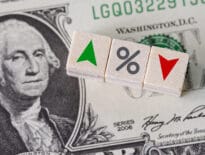
Federal Reserve Chair Jerome Powell, center, and board member Lael Brainard, right, meet with other members of the interest rate-setting Federal Open Markets Committee on March 15 or 16, 2022. Federal Reserve photo
The Federal Reserve’s decision to hike interest rates a quarter-percent Wednesday agrees with most economists’ assessments that sharply higher rates are long overdue to combat the escalation of inflation across the economy.
But many also worry that with inflation already so high – it reached 7.9 percent in February, the worst in four decades – and with Russia’s invasion of Ukraine driving up gas prices, the Fed may have to raise rates even higher than it now expects and potentially cause a recession.
At his news conference, Powell stressed his confidence that the economy is strong enough to withstand higher interest rates. But he also made clear that the Fed is focused on doing whatever it takes to reduce inflation, over time, to its 2 percent annual target. Otherwise, Powell warned, the economy might not sustain its recovery from the pandemic recession.
“We’re acutely aware of the need to restore price stability,” the Fed chair said. “In fact, it’s a precondition for achieving the kind of labor market that we want. You can’t have maximum employment for any sustained period without price stability.”
The Fed also released a set of quarterly economic projections Wednesday that underscored the potential for extended interest rate increases in the months ahead. Seven hikes would raise its short-term rate to between 1.75 percent and 2 percent at the end of 2022. Fed officials also forecast four more rate increases in 2023, which would boost its benchmark rate to 2.8 percent.
That would be the highest level since March 2008. Borrowing costs for mortgage loans, credit cards and auto loans will likely rise as a result. The Mortgage Bankers Association said Wednesday it forecasts rates on the standard 30-year, fixed-rate mortgage will hit 4.5 percent this year.
“Clearly, inflation has moved front and center into the Fed’s thinking,” said Tim Duy, chief U.S. economist at SGH Macro Advisers.
Growth Forecasts Slow
The central bank’s policymakers expect inflation to remain elevated, ending 2022 at 4.3 percent, according to quarterly projections they released Wednesday. The officials also now forecast much slower economic growth this year, of 2.8 percent, down from a 4 percent estimate in December.
New data from the federal Commerce Department released Wednesday shows that after beginning the year in a buying mood, Americans slowed their spending in February on gadgets, home furnishings and other discretionary items as higher prices for food, gasoline, and shelter are taking a bigger bite out of their wallet.
“The problem is that as households get more and more squeezed on essentials, there is less budget available for discretionary spending,” said Neil Saunders, managing director at GlobalData Retail. “True, there is an elevated buffer of savings which consumers can call upon to fund their consumption, but this is a short-term fix in an environment where inflation is becoming a persistent problem.”
Russia’s invasion of Ukraine could also sent prices for food and several key commodities higher. In a grim new assessment Thursday, the 38-country Organization for Economic Cooperation and Development said that over the next year, the conflict would reduce gross domestic product – the broadest measure of economic output – by 1.08 percent worldwide, by 1.4 percent in the 19 European countries that share the euro currency and by 0.88 percent in the United States.
Russia and Ukraine account for less than 2 percent of global GDP but are heavyweight producers of specific commodities. Together, for instance, they export a third of the world’s wheat, raising concerns that countries like Egypt and Lebanon that rely on those affordable wheat exports for bread and other food staples could face shortages in the months ahead.
Russia is also a big producer of potash that is used in fertilizer, palladium that is critical for cars, cellphones and dental fillings and nickel used in electric car batteries and steel. Prices of those commodities have surged since January.
Is Economy Robust Enough?
By its own admission, the central bank underestimated the breadth and persistence of high inflation after the pandemic struck. And many economists say the Fed has made its task riskier by waiting too long to begin raising rates.
The Fed’s projections show that by the end of next year, the policymakers expect their short-term rate to be above “neutral” – the level at which they think the rate neither fuels nor slows economic growth.
Roberto Perli, an economist at Piper Sandler, questioned Powell’s assurances that the economy could withstand such higher rates.
“In the past, whenever the Fed has approached – let alone exceeded– neutral, the economy weakened sharply,” Perli wrote in a note to clients. “The risk of recession in 2023 and beyond is increasing.”
Yet Powell downplayed the likelihood of an economic setback.
“The probability of a recession in the next year is not particularly elevated,” he said.
Powell Banks on Bottlenecks Easing
At his news conference, Powell said he believed that inflation would slow later this year as supply chain bottlenecks clear and more Americans return to the job market, easing upward pressure on wages.
He also suggested that over time, the Fed’s higher rates will reduce consumer spending on interest rate-sensitive items like autos and cars. Americans may also buy less as credit card rates increase. Those trends would eventually reduce businesses’ demand for workers and slow pay raises, which are running at a robust 6 percent annual rate, and ease inflation pressures.
Powell noted that there are a near-record number of job openings, leaving 1.7 available jobs, on average, for every unemployed person. As a result, he expressed confidence that the Fed can lower demand for workers and wage growth without increasing unemployment.
“All signs are that this is a strong economy,” he said, “one that will be able to flourish in the face of less accommodative monetary policy.”
The Fed’s forecast for numerous additional rate hikes in the coming months initially disrupted a strong rally on Wall Street, weakening stock gains and sending bond yields up. But stock prices more than recovered their gains soon after the press conference began.
AP staff writer Anne D’Innocenzio contributed to this story.




 |
| 

